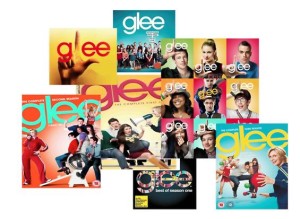The UK Court of Appeal recently upheld the High Court’s decision that the use of ‘glee’ by Twentieth Century Fox (‘Fox’) as the name of its comedy TV series infringed an earlier trade mark registration for THE GLEE CLUB. So called ‘wrong way round’ confusion played a central role in this.
The claimant (and respondent in the appeal), Comedy Enterprises Ltd, had a UK series registration dating to 2001 of these logos, covering a range of class 41 services including live comedy services and provision of live and recorded music:
The defendant, Fox, launched a musical comedy TV series called ‘glee’ in the US and UK in late 2009, using the sign on the TV series, a related live show, and DVDs of various episodes of the series in a number of contexts including these:
Comedy Enterprises brought proceedings against Fox for trade mark infringement and passing off in September 2011. The High Court found (see [2014] EWHC 185 (Ch)) that Fox infringed under sections 10(2) and (3) of the UK Act: respectively, by using a similar sign on similar services with resulting confusion, and by using a similar sign without due cause which was detrimental to the distinctive character or repute of Comic Enterprises’ mark. Significantly, although Fox was the later user by many years, the profile and popularity of its TV series – and therefore its exposure to relevant consumers – grew quickly. Consequently, the High Court found in Comic Enterprises’ favour principally on the basis of evidence showing that consumers familiar with the ‘glee’ TV series, who then came across THE GLEE CLUB, mistakenly inferred a connection with the Fox TV series. This evidence was pivotal to Comic Enterprises’ success under both infringement grounds.
Fox appealed against this decision (see [2016] EWCA Civ 41) on various grounds. Central to their appeal, however, were arguments that this so-called ‘wrong way round’ confusion was not only factually irrelevant to the infringement issue, but also irrelevant as a matter of law. The Court of Appeal, through the leading judgment of Kitchen LJ, reviewed this issue in some detail and decided that it must examine all of Comic Enterprises’ evidence for itself (para. 45). Following that analysis, Kitchen LJ found that ‘a good deal of it’ was generally supportive of their case. He went on to conclude:
- that nothing in the statutory infringement provisions excludes the possibility of ‘wrong way round’ confusion;
- that whether confusion is ‘wrong way round’ or ‘right way round’ may be due to nothing more than the order in which the consumer happened to come across the mark and the sign;
- that evidence of ‘wrong way round’ confusion may be probative of a risk of ‘right way round’ confusion; and
- that although in principle admissible, ‘wrong way round’ confusion must be carefully assessed with all the other evidence to see if it actually assists in the evaluation of the statutory infringement question.
This is a significant judgment. Although ‘wrong way round’ confusion has been considered in the High Court several times in recent years (see para. 83 for a list of these), this analysis of the Court of Appeal authoritatively reinforces its legitimate place within the infringement arena. The greater the exposure of a later mark to its consumers and the more quickly the scale of its use has grown, the more likely it is that a claimant with a less well-known mark may be able to benefit from the resulting reputation in support of its own infringement case.
_____________________________
To make sure you do not miss out on regular updates from the Kluwer Trademark Blog, please subscribe here.




